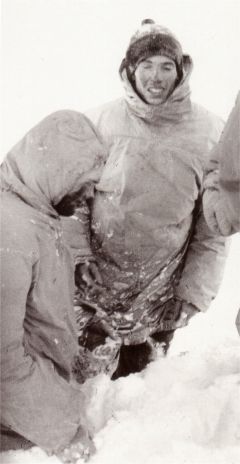
Avalanches > Search And Rescue > Vincendon and Henry > The Prisoners Of Mont Blanc
Frozen and exhausted the two French had trouble keeping pace with Bonatti, They must reach the relative safety of the refuge by nightfall. Vincendon wanted to stop to eat, but in three hours it would be night. Gheser started to take his rucksack off his back but was brought to his senses by Bonatti. With the wind, the effective temperature was minus 70. "If you stop, you will die" Bonatti told them in no uncertain terms. Gheser picked up his sac and began to follow, separating the rope. Bonatti and Gheser reached the Vallot just as night fell. Gheser suffering from severe frostbite which would cost him his toes. Bonatti wanted to go back alone to search for Vincendon and Henry but Gheser persuaded him to stay at the refuge.
Down in Chamonix their friends began to worry. Duf, accompanied with two other friends went to the guides office. With the Malabar Princess still fresh in their memory the response was a firm No. The guides would not risk their lives when the climbers had already been advised against a winter ascension. On the 27th the friends decided to take action themselves and took the Houches cable car to reach the Tete Rouse refuge. The SCSM (Societe Chamoniarde de Secours en Montage) also decided to act and asked for a Sikorski helicopter, based near Chambery, to overfly the mountain. Meanwhile at the summit of Planpraz, Marcel Simond spotted two figures below the Rochers Rouges. He sent a message to the Police in Chamonix: They are exhausted, one falls repeatedly. A policeman joined him and confirmed the sighting but the information wasnt passed to the helicopter. Bonatti and Gheser questioned the helicopter crews observation skills. They over flew the two men at low altitude but didnt notice their signals for help. Shortly after Bonatti fell in a crevasse, his life only saved by Gheser. A favour returned.

Vincendon and Henry
On the 28th, without knowing they had been spotted by Simond, the two men were in a terrible state. Two bivouacs in awful conditions, after a day's climbing they would spend another night at 4,200 meters. The next day they descended a further 200 meters until they were blocked by seracs at the edge of the Grand Plateau. At 14h00 they heard a helicopter, but in the thin mountain air the piston engined Sikorsky was ill adapted to land. Packets were dropped with food and a tent. A message was attached, climb to the Grand Plateau where we can rescue you. Why didnt they land on the Grand Plateau and send the two guides they were carrying to rescue the men? In any case the packages were of little use. The stricken climbers had lost their gloves and their frozen fingers would be unable to unpick the knots on the parcels. They were also half blind with the snow.
The 29th was a fine day. At 8am the climbers friends, accompanied by the guide Claude Jaccoux, waited for a helicopter to take them to the Dome du Gouter from where they planned to reach the two men. But the helicopter never came. Based at Le Fayet at 575 meters altitude it was blocked by fog, a frequent problem in the area. The press started to become interested, Paris-Match, le Dauphiné Libéré and Europe 1 began to ask questions about the speed of the rescue operation. Imprudent, yes, but did they deserve to be taught such a harsh lesson? By now all of France was watching as the events unfolded.
The guide Lionel Terray, part of the 1950 Annapurna team and with considerable winter climbing experience was now back in Chamonix after a conference in Val dIsère. He knew the stricken climbers and their friends personally and wanted to know why more wasnt being done to help. He asked his colleagues in the Guides office to help organise a ground based rescue. They refused, some believing that Terray wanted to take advantage of the situation to appear the hero.
Commander Legall, head of the Military Mountaineering School (EMHM) was put in charge of operations. He called for a bigger helicopter, a Sikorsky S58, the pride of the French army. The plan was now to drop a team of guides on the Gouter to fetch the two climbers using skis. The operation would take seven hours, so it was important to be ready at 10h00 the next day. On the 30th the weather was poor and the helicopters were again stuck at their base. Terray decided to set-out on foot with the climbers friends. The guides would follow them the next day, however the SCSM decided to block any ground based rescue. It took the intervention of Lucien Devies, the head of the French Mountaineering Federation (FFM), to overturn that decision and give permission to Terray. In Chamonix tempers were fraying mountain folk against townies, guides against Terray, everyone was arguing but little seemed to be happening while Vincendon and Henry prepared for their sixth night in the open.
<< A Fateful Meeting with Bonatti | Vincendon and Henry | L'Elephant Crashes >>